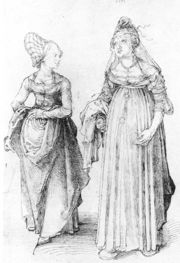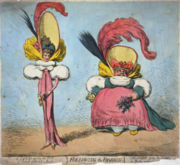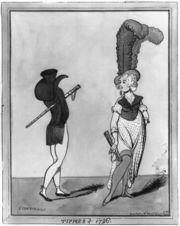Fashion
2008/9 Schools Wikipedia Selection. Related subjects: Everyday life
Fashion refers to styles of dress (but can also include cuisine, literature, art, architecture, and general comportment) that are popular in a culture at any given time. Such styles may change quickly, and "fashion" in the more colloquial sense refers to the latest version of these styles. Inherent in the term is the idea that the mode will change more quickly than the culture as a whole.
The terms "fashionable" and "unfashionable" are employed to describe whether someone or something fits in with the current or even not so current, popular mode of expression. The term "fashion" is frequently used in a positive sense, as a synonym for glamour, beauty and style. In this sense, fashions are a sort of communal art, through which a culture examines its notions of beauty and goodness. The term "fashion" is also sometimes used in a negative sense, as a synonym for fads and trends, and materialism. A number of cities are recognized as global fashion centers and are recognized for their fashion weeks, where designers exhibit their new clothing collections to audiences. These cities are New York City, Milan, Paris, and London. Other cities, mainly Los Angeles, Berlin, Tokyo, Rome, Miami, Hong Kong, São Paulo, Sydney, Madrid, Vienna, and Dubai also hold fashion weeks and are better recognized every year.
Areas of fashion
Fashions are social phenomena common to many fields of human activity and thinking. The rise and fall of fashions has been especially documented and examined in the following fields:
- Architecture, interior design, and landscape design
- Arts and crafts
- Body type, clothing or costume, cosmetics, personal grooming, hairstyle, and personal adornment
- Dance and music
- Forms of address, slang, and other forms of speech
- Economics and spending choices, as studied in behavioural finance
- Entertainment, games, hobbies, sports, and other pastimes
- Etiquette
- Management, management styles and ways of organizing
- Politics and media, especially the topics of conversation encouraged by the media
- Philosophy and spirituality (One might argue that religion is prone to fashions, although official religions tend to change so slowly that the term cultural shift is perhaps more appropriate than "fashion")
- Social networks and the diffusion of representations and practices
- Sociology and the meaning of clothing for identity-building
- Technology, such as the choice of computer programming techniques
- Hospitality industry such as designer uniforms custom made for a hotel, restaurant, casino, resort or club, in order to reflect a property and brand. see "uniforms"
Of these fields, costume especially has become so linked in the public eye with the term "fashion" that the more general term "costume" has mostly been relegated to only mean fancy dress or masquerade wear, while the term "fashion" means clothing generally, and the study of it. This linguistic switch is due to the so-called fashion plates which were produced during the Industrial Revolution, showing novel ways to use new textiles. For a broad cross-cultural look at clothing and its place in society, refer to the entries for clothing, costume and fabrics. The remainder of this article deals with clothing fashions in the Western world.
Clothing
The habit of people continually changing the style of clothing worn, which is now worldwide, at least among urban populations, is generally held by historians to be a distinctively Western one. At other periods in Ancient Rome and other cultures changes in costume occurred, often at times of economic or social change, but then a long period without large changes followed. In 8th century Cordoba, Spain, Ziryab, a famous musician - a star in modern terms - is said to have introduced sophisticated clothing styles based on seasonal and daily timings from his native Baghdad and his own inspiration.
The beginnings of the habit in Europe of continual and increasingly rapid change in styles can be fairly clearly dated to the middle of the 14th century, to which historians including James Laver and Fernand Braudel date the start of Western fashion in clothing. The most dramatic manifestation was a sudden drastic shortening and tightening of the male over-garment, from calf-length to barely covering the buttocks, sometimes accompanied with stuffing on the chest to look bigger. This created the distinctive Western male outline of a tailored top worn over leggings or trousers which is still with us today.
The pace of change accelerated considerably in the following century, and women and men's fashion, especially in the dressing and adorning of the hair, became equally complex and changing. Art historians are therefore able to use fashion in dating images with increasing confidence and precision, often within five years in the case of 15th century images. Initially changes in fashion led to a fragmentation of what had previously been very similar styles of dressing across the upper classes of Europe, and the development of distinctive national styles, which remained very different until a counter-movement in the 17th to 18th centuries imposed similar styles once again, finally those from Ancien Régime in France. Though fashion was always led by the rich, the increasing affluence of early modern Europe led to the bourgeoisie and even peasants following trends at a distance sometimes uncomfortably close for the elites - a factor Braudel regards as one of the main motors of changing fashion.
The fashions of the West are generally unparalleled either in antiquity or in the other great civilizations of the world. Early Western travellers, whether to Persia, Turkey, Japan or China frequently remark on the absence of changes in fashion there, and observers from these other cultures comment on the unseemly pace of Western fashion, which many felt suggested an instability and lack of order in Western culture. The Japanese Shogun's secretary boasted (not completely accurately) to a Spanish visitor in 1609 that Japanese clothing had not changed in over a thousand years. However in Ming China, for example, there is considerable evidence for rapidly changing fashions in Chinese clothing,

Ten 16th century portraits of German or Italian gentlemen may show ten entirely different hats, and at this period national differences were at their most pronounced, as Albrecht Dürer recorded in his actual or composite contrast of Nuremberg and Venetian fashions at the close of the 15th century (illustration, right). The "Spanish style" of the end of the century began the move back to synchronicity among upper-class Europeans, and after a struggle in the mid 17th century, French styles decisively took over leadership, a process completed in the 18th century.
Though colors and patterns of textiles changed from year to year, the cut of a gentleman's coat and the length of his waistcoat, or the pattern to which a lady's dress was cut changed more slowly. Men's fashions largely derived from military models, and changes in a European male silhouette are galvanized in theatres of European war, where gentleman officers had opportunities to make notes of foreign styles: an example is the "Steinkirk" cravat or necktie.
The pace of change picked up in the 1780s with the increased publication of French engravings that showed the latest Paris styles; though there had been distribution of dressed dolls from France as patterns since the 16th century, and Abraham Bosse had produced engravings of fashion from the 1620s. By 1800, all Western Europeans were dressing alike (or thought they were): local variation became first a sign of provincial culture, and then a badge of the conservative peasant.
Although tailors and dressmakers were no doubt responsible for many innovations before, and the textile industry certainly led many trends, the history of fashion design is normally taken to date from 1858, when the English-born Charles Frederick Worth opened the first true haute couture house in Paris. Since then the professional designer has become a progressively more dominant figure, despite the origins of many fashions in street fashion.
Modern Westerners have a wide choice available in the selection of their clothes. What a person chooses to wear can reflect that person's personality or likes. When people who have cultural status start to wear new or different clothes a fashion trend may start. People who like or respect them may start to wear clothes of a similar style.
Fashions may vary considerably within a society according to age, social class, generation, occupation sexual orientation, and geography as well as over time. If, for example, an older person dresses according to the fashion of young people, he or she may look ridiculous in the eyes of both young and older people. The terms "fashionista" or " fashion victim" refer to someone who slavishly follows the current fashions
One can regard the system of sporting various fashions as a fashion language incorporating various fashion statements using a grammar of fashion. (Compare some of the work of Roland Barthes.)
Changes
Fashion, by description, changes constantly. The changes may proceed more rapidly than in most other fields of human activity (language, thought, etc). For some, modern fast-paced changes in fashion embody many of the negative aspects of capitalism: it results in waste and encourages people qua consumers to buy things unnecessarily. Other people enjoy the diversity that changing fashion can apparently provide, seeing the constant change as a way to satisfy their desire to experience "new" and "interesting" things. Note too that fashion can change to enforce uniformity, as in the case where so-called Mao suits became the national uniform of mainland China.
At the same time there remains an equal or larger range designated 'out of fashion'.(These or similar fashions may cyclically come back 'into fashion' in due course, and remain 'in fashion' again for a while.)
Practically every aspect of appearance that can be changed has been changed at some time, for example skirt lengths ranging from ankle to mini to so short that it barely covers anything, etc. In the past, new discoveries and lesser-known parts of the world could provide an impetus to change fashions based on the exotic: Europe in the eighteenth or nineteenth centuries, for example, might favour things Turkish at one time, things Chinese at another, and things Japanese at a third. A modern version of exotic clothing includes club wear. Globalization has reduced the options of exotic novelty in more recent times, and has seen the introduction of non-Western wear into the Western world.
Fashion houses and their associated fashion designers, as well as high-status consumers (including celebrities), appear to have some role in determining the rates and directions of fashion change.
Intellectual property
Within the fashion industry, intellectual property is not enforced as it is within the film industry and music industry. While brand names and logos are protected, designs are not. Smaller, boutique, designers have lost revenue after their designs have been taken and marketed by bigger businesses with more resources. Some observers have noted, however, that the relative freedom that fashion designers have to "take inspiration" from others' designs contributes to the fashion industry's ability to establish clothing trends. Enticing consumers to buy clothing by establishing new trends is, some have argued, a key component of the industry's success. Intellectual property rules that interfere with the process of trend-making would, on this view, be counter-productive. In 2005, the World Intellectual Property Organization (WIPO) held a conference calling for stricter intellectual property enforcement within the fashion industry to better protect small and medium businesses and promote competitiveness within the textile and clothing industries.


